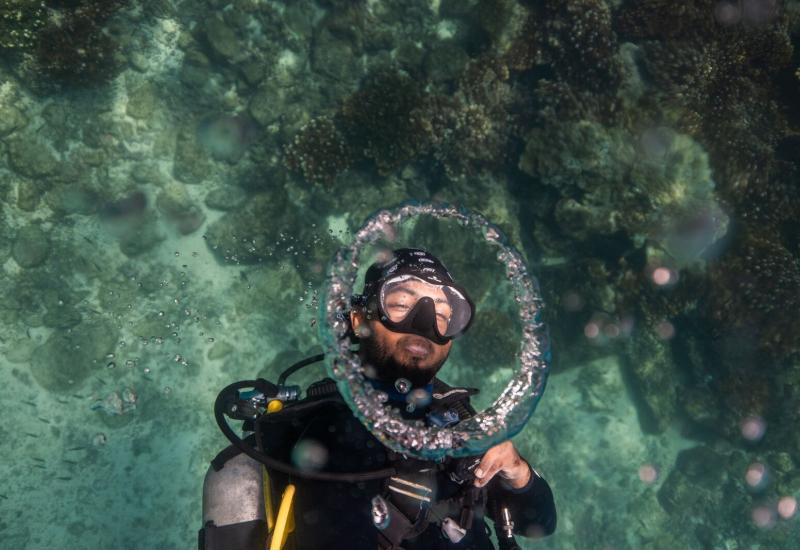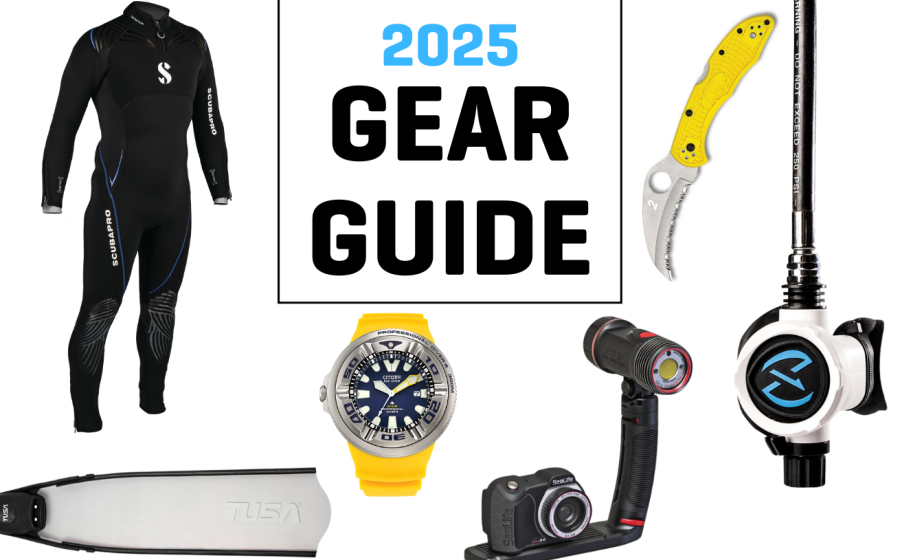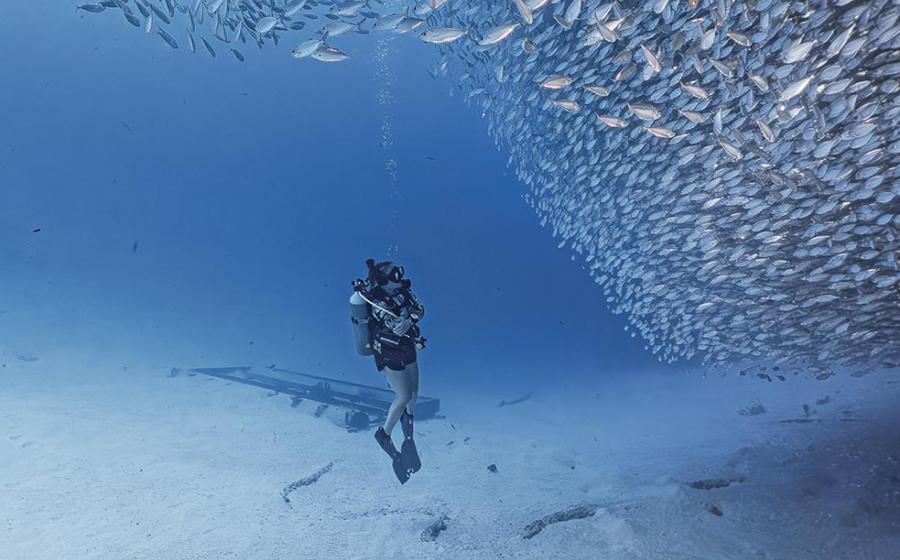Diving French Polynesia’s Tuamotu Islands
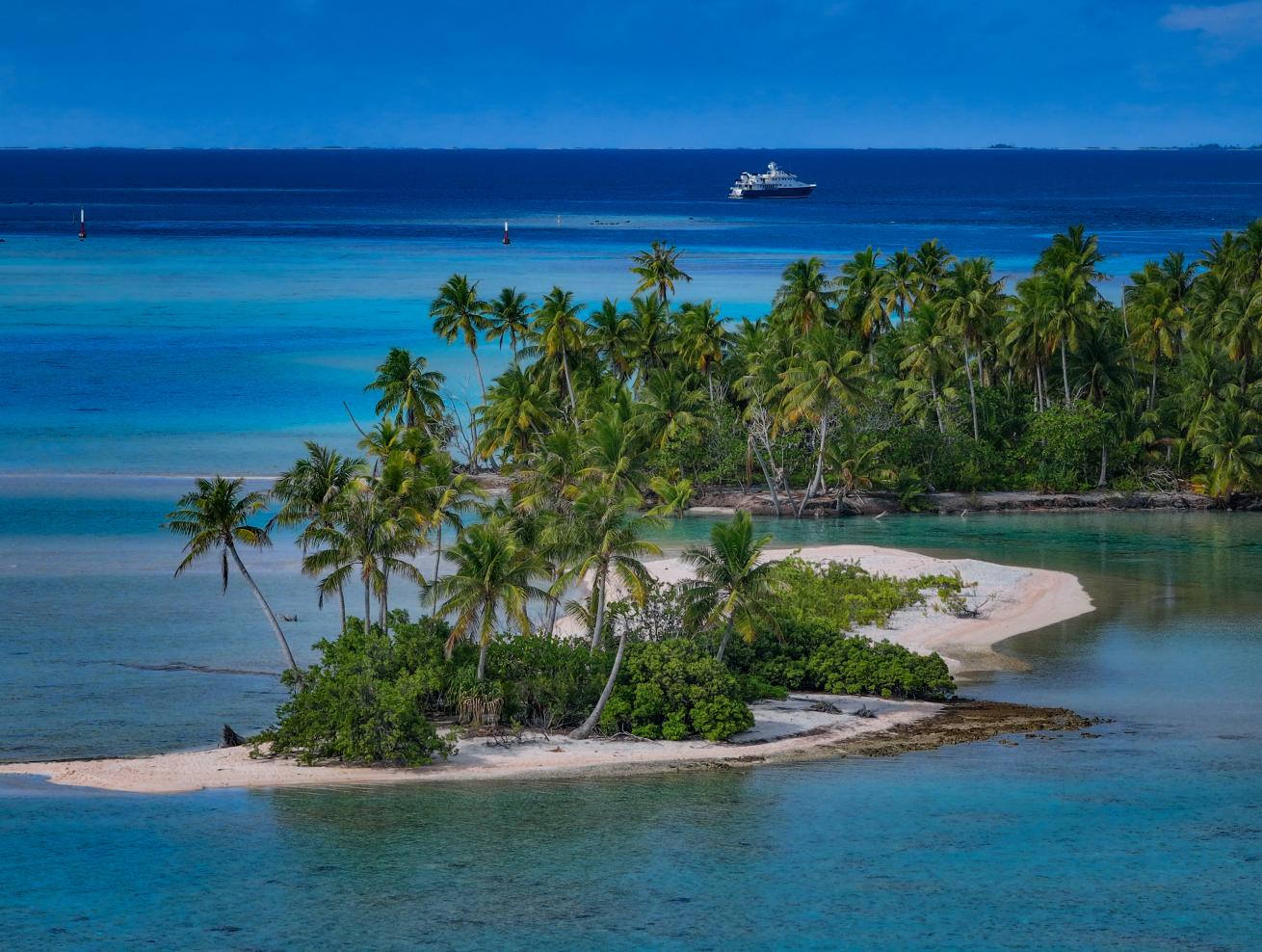
Courtesy EYOS ExpeditionsThe Hanse Explorer, chartered by EYOS Expeditions, anchors near a French Polynesian atoll.
The air is heavy with tropical heat as I walk out of Faa’a Airport in Tahiti, French Polynesia. I’m jet-lagged and dehydrated, but I have to rally. This is no ordinary dive trip. Awaiting me is five days of diving at its most luxurious—cruising on an expedition superyacht through the Tatamous islands—and the bespoke itinerary begins during the layover.
With a few hours to fill before my group flies to Fakarava to meet the Hanse Explorer, a tender is waiting for us just minutes from the airport at the InterContinental Tahiti Resort & Spa. Why sit at the airport when you can go whale snorkeling instead?
Ushered quickly from tarmac to dock, our tender carves a path through the impossibly blue waters, framed by the lush peaks of Tahiti on one side and the hazy outline of Mo’orea on the other. We drift, scanning the horizon, and I begin to temper my expectations, questioning if it was a bit too ambitious of me to think I could swim with humpbacks on a layover. All of a sudden, a whale breaches in the distance. Seconds later, her calf surfaces beside her.
Hearts pounding, we quickly slide into the water. The calf approaches us first, its movements curious and unhurried. Below, the mother looms like a shadow, enormous and impossibly gentle as she rises to meet us. For a few moments, they are close enough that I can see the texture of their skin, each ripple a story written by the ocean. Then, as quietly as they had appeared, they dissipate into the blue.
This encounter sets the tone for what was to come: a week of extraordinary wildlife, transformative dives, and the ultimate blend of rugged exploration and indulgent comfort aboard the Hanse Explorer. After all, this is no ordinary dive trip—this is expedition yachting with EYOS Expeditions.
Welcome Aboard

Courtesy EYOS ExpeditionsThe Hanse Explorer's refurbished interiors deliver luxury in remote locations.
French Polynesia is a vast, sprawling expanse of 118 islands and atolls scattered across 2 million square miles. The Tuamotu Archipelago, one of five island clusters, comprises nearly 80 islands and coral atolls, encircled by shallow lagoons where life thrives in vivid color. Fakarava and Rangiroa, two of its atolls, are designated as UNESCO Biosphere Reserves, renowned for their abundance and diversity.
The diving in the Tuamotu is incomparable. These remote regions have a raw magic that draws even the most seasoned divers back time and again. The legendary passes, where ocean meets lagoon, are alive with thrilling marine spectacles. Gray reef sharks cut through currents with ease, jackfish glitter like spilled silver, and scad move with understated grace. Dolphins and rays glide seamlessly into view, their paths dictated by the vibrant pulse of water flowing between lagoon and ocean. In Fakarava’s South Pass, the iconic “Wall of Sharks” presents a breathtaking dance of hundreds, moving in perfect harmony. Meanwhile, the North Pass's strong, fast currents deliver an adrenaline-pumping rush.
These are no entry-level dives. The Tuamotus demand skill, respect, and a guide who knows these waters intimately. But those who rise to the occasion will be richly rewarded—this is the kind of diving that inspires you to get certified in the first place.
Amid the shifting currents of the Tuamotus, the Hanse Explorer becomes both base camp and lavish resort. Yachting generally focuses on luxury and leisure: cruising in calm waters, an itinerary focused on aesthetics and comfort. Expedition yachting takes this to the next level—it brings all that grandeur to remote locales. You put all the traditional yachting amenities on durable, self-sufficient vessels built to endure extreme conditions. This unlocks adventures in remote areas without a single sacrifice.
“You're taking this expedition yacht with all her capabilities—as well as amazingly comfortable accommodation—with you to some really inaccessible areas and using her as a launchpad to get ashore or out into the water and see wild places you wouldn't otherwise be able to reach,” Tim Soper, co-founder of EYOS Expeditions, tells me.
Running distinctive trips like this is their specialty: they facilitate upwards of 70 expeditions annually to some of the world's most remote locations, including Antarctica, the Arctic, and the Northwest Passage. These custom excursions can include pretty much anything you can dream up. They've even set several world records, including the southernmost expedition and executing the Five Deeps Expedition, Victor Vescovo’s global adventure taking a manned submersible to the deepest points of all five oceans.
The Hanse Explorer is just one of the many yachts for which EYOS oversees charters. Even among this rarified group, she isn't your typical super yacht. My heart jumps into my throat when I see her glistening in the waters of Fakarava after our plane from Tahiti touches down. Her steel hull is capable of navigating polar ice for her annual polar expeditions and is laid out with exploration in mind. Yet, luxury remains uncompromised onboard: guests can unwind in a Finnish sauna or a top-deck jacuzzi, savor lunches of lamb shanks and fresh fruit on the panoramic back deck, and relax with Starlink internet in beautifully appointed private cabins. Plus, thanks to the fully-equipped compressor in the freshly-installed dive locker, there is always access to nitrox for diving.
What more could you ask for? I truly couldn’t think of a thing.

Courtesy EYOS ExpeditionsHundreds of grey reef sharks aggregate daily in Fakarava's South Pass.
The Great Wall of Sharks
Our first day aboard starts with Fakarava’s legendary South Pass As we arrive, I instantly see why.
“The South Pass of Fakarava is a connection between the ocean and the lagoon,” explains Yannis St-Pe, our EYOS guide who has spent three decades diving these waters. “It’s a long channel. It gets narrower and shallower at the end, and this is where the sharks gather. There’s nothing like it anywhere else.”
As I eagerly slip into the water, the current seizes me like an invisible hand, drawing me into its flow. Below, the hard coral stretches out in rugged formations.
But it isn’t the coral that commands my attention.
First, the scad fish arrive. Hundreds of them, glinting like a flowing river of silver, dance in mesmerizing sync beneath the sun-dappled surface.
Then the sharks begin to cut through the school with authoritative ease, claiming their dominion. Everywhere I look, sharks fill the water column—dozens upon dozens of reef sharks form the infamous Wall of Sharks, all gliding with unhurried confidence. Some swim just above the coral, their forms blending with the reef, while others move higher, silhouettes against the light filtering from the surface.
“There are so many sharks there,” Yannis tells me, “a French research team counted more than 700 individual sharks at this site in 24 hours.”
I don’t bother counting—it’s easy to believe that figure in the endless cloud of fins. Elemental and serene, they float in a rhythm dictated by the currents that shape their world. I am spellbound, momentarily forgetting the tug of the current, the rhythm of my breath, GoPro in my hand. I become absorbed in my role of spectator at the most spectacular show on Earth.
Just as I am convinced it couldn’t get more impressive, a Napoleon wrasse made its grand entrance. Its size is formidable, its moody colors so striking they seemed painted on. It circles around me slowly, with the poise of a gunslinger sizing up an opponent. The sharks paid it no mind—too big to bother with—but to me, it was a brilliant addition to an already stunning ensemble.
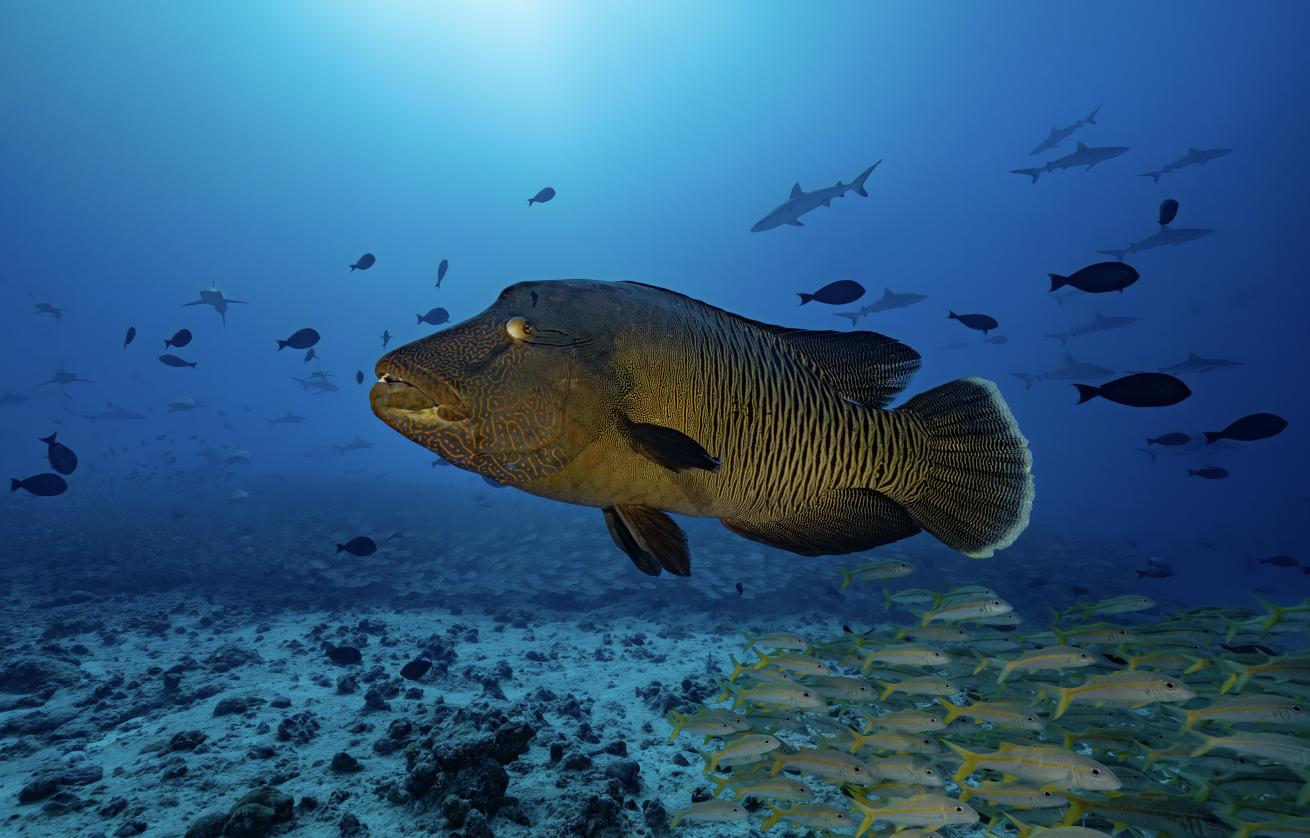
Courtesy EYOS ExpeditionsA humphead wrasse sails over the reef in Fakarava.
Clinging to the rough substrate to anchor myself against the current, I suddenly find myself eye-to-eye with a shark. It floats ten feet away, calm and commanding in the swift-moving water. It is master of the currents. I, meanwhile, struggled to maintain my position, awkwardly adjusting under the scrutinizing gaze of my newfound buoyancy mentor.
Watching it, I feel like I am witnessing the essence of the ocean itself: timeless, unrelenting, and awe-inspiring.
Catch My Drift
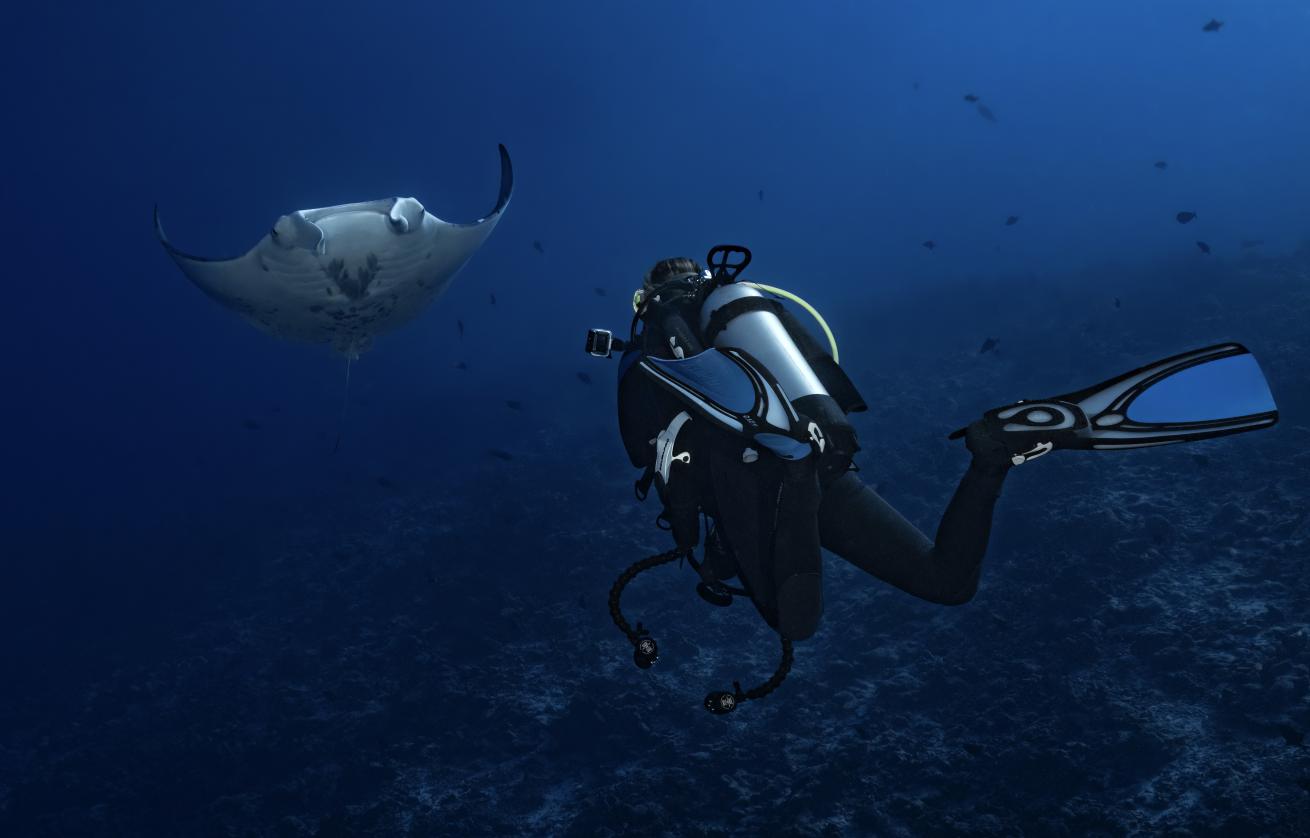
Courtesy EYOS ExpeditionsAn oceanic manta circles back to soar over a lucky diver.
Encounters come with the force of a riptide our entire trip. At the Otugi Pass, an oceanic manta bursts from the blue to glide effortlessly over a fellow diver before floating at a cleaning station for more than five minutes. In Rangiroa, we spend a joyful half-an-hour snorkeling with twirling, twisting dolphins in the comfort of the atoll.
“In 30 years I have never seen the dolphins inside the atoll,” Yannis remarks later. “That was really special.”
Truer words have never been spoken. Where else do you get to encounter humpback whales, sharks, mantas, and dolphins in just four days?
And the delights are far from finished. Another powerful force waits to whisk me away: The pulse-pounding drift dive at Fakarava’s North Pass. A site that is only safe to dive during the incoming tide, the dive briefing is clear: when on the wall, avoid the down current at all costs.
Related Reading: Diving Lake Keowee, South Carolina
“The North Pass is a huge, deep pass with strong currents,” says Yannis. “You need to be an advanced diver because it’s quite deep, like 30 meters. But it’s fantastic—you’ve got schools of sharks and canyons to drift over.”
We drop in and are immediately greeted by a bustling reef, alive with sharks and vibrant schools of fish. At 90 feet, I find myself gripping a rock tightly, the current testing my hold while hundreds of sharks swim just feet away. To my left, a crowd of gray reef sharks slope into the depths; in front of me, the water column teems with another undulating aggregation. For 20 minutes, I watch this hypnotic scene—a pulsating intersection of life at the edge of the reef, where the tame shallows collide with the endless ocean.
My air reaches 100 bar, and it’s time to let go. The current seizes me instantly, pulling us away from the wall and into the inviting azure of the reef. We fly over a hardscape dotted with enough starfish to form constellations. It feels like flying over the night sky itself as dwindling air forces us right past the 500 Shark Pit, a deep divot in the middle of the pass where even more sharks aggregate. (Consider seeing that site reason a million and one I’ll have to return to the Tatamous.)
Riding at 40 feet, the force pulls us quickly— nearly a mile—but the wild, weightless ride is serene, gliding through a dream. And isn’t a reef that goes on and on and on every diver’s dream?
“That has to be one of the best dives I’ve ever had,” fellow diver India says as we haul ourselves back onto the Zodiac. “I will remember this dive for the rest of my life.”
The Perks of an Expedition
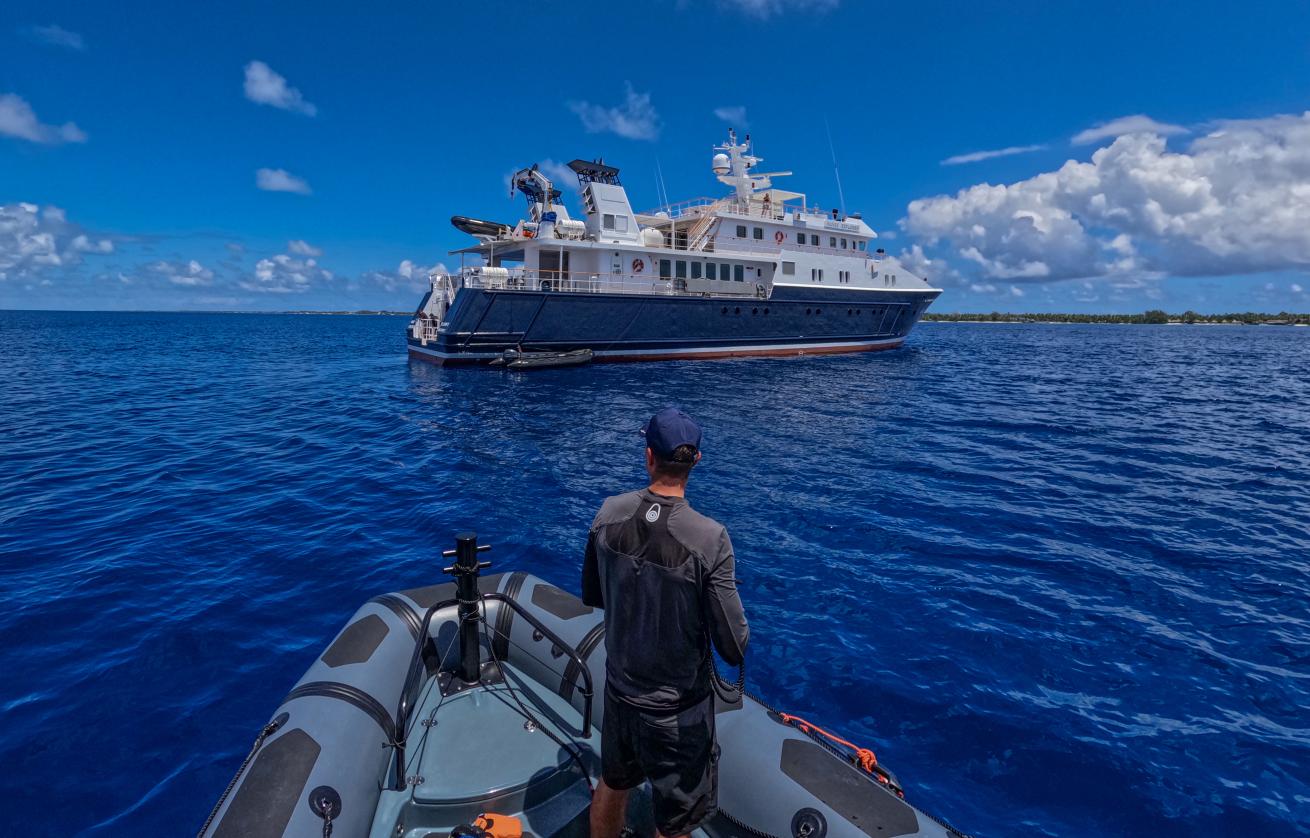
Courtesy EYOS ExpeditionsDivers return to the Hanse Explorer, their floating base camp, in between dives.
Our final day turns into a microcosm of everything extraordinary about expedition yachting. It encapsulates freedom, adventure and unparalleled service offered in the middle of absolutely nowhere.
Dawn breaks over our final stop: Makatea, a tiny speck in the ocean with just 60 inhabitants. The crew’s sharp eyes spot a mother humpback whale and her calf gliding through the nearby waters before breakfast. We have a full day planned: a villa visit, a cultural tour, and a private beach picnic before the trip’s final dive. But, come on — whales! Can we go snorkeling during the day instead of diving, we ask the crew?
“Of course!” they say. One perk of a private expedition is that we aren’t bound to any rigid schedule. We can tap into any magic as it arises.
While the crew keeps an eye on the whale pair for us, the Zodiac drops us at the harbor constructed back when Makatae housed a major phosphate mine. The atoll’s small population are largely the descendants of the workers who chose not to relocate to a different atoll when the mine closed in 1962. Among them is our guide, who’s waiting in a pickup truck packed with gear. In a brief two-minute drive we’re at the base of the day’s first adventure: A via ferrata, or pre-set climbing trail of steel cables, rungs, and ladders fixed into a vertical rock face.
There’s no warm-up. We’re straight into it.
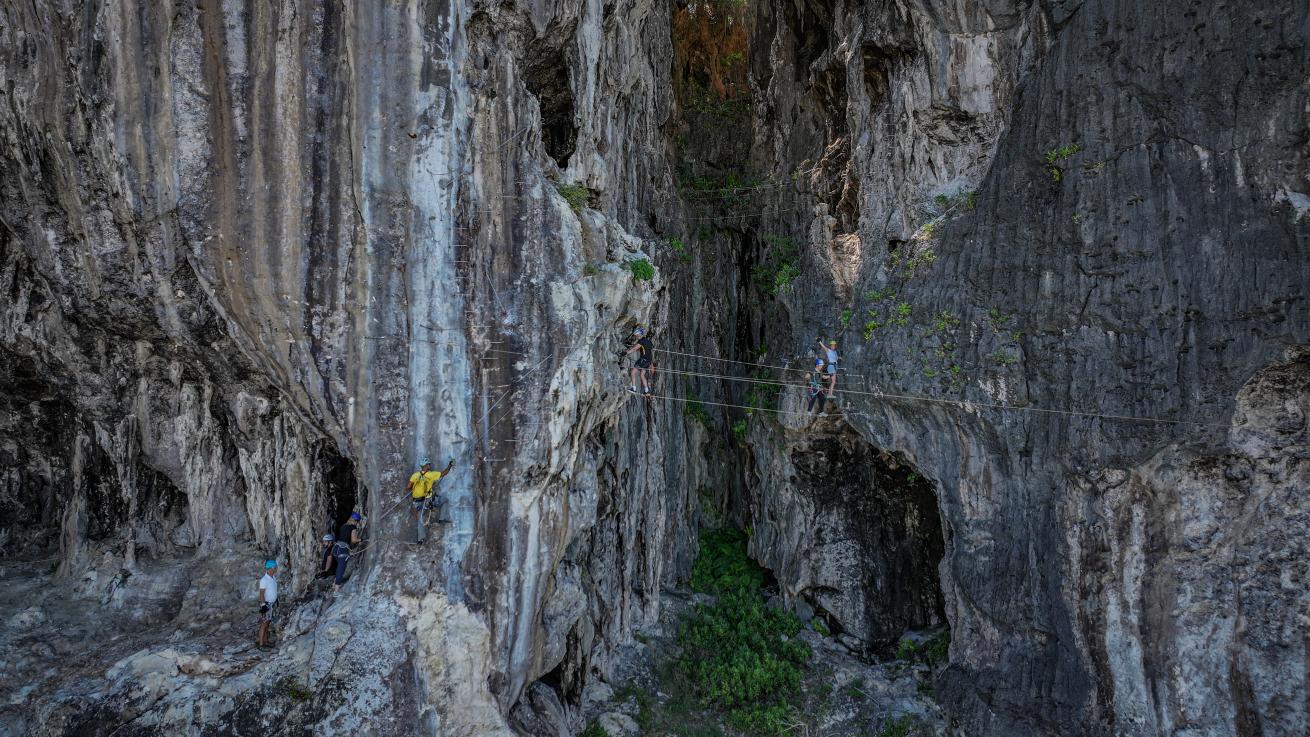
Courtesy EYOS ExpeditionsThe author (in a green shirt) traverses a villa ferrata on Makatea during a day of land-based adventures organized by EYOS Expeditions.
Harnesses on. Three safety lines clipped to our waists—two long, one short. Helmets snug. Zip line attachment hanging ominously from the back of my harness like a foreshadowing. We start with a vertical ladder drilled into the rock, clipping in at every rung. Then a shimmy around the edge of a coral wall, the stone razor-sharp, fossilized teeth from an ancient reef.
Steel steps twist up the face of the cliff. We cross a cable bridge — the kind that tests your trust in physics — before threading left through a canyon. Sunlight pours through a hole above and waves hammer the beach behind us, postcard-beautiful.
Another bridge, more cliff face. This time we’re edging our way back toward open air, one carabiner at a time. And then comes the part I’ve been both anticipating and dreading.
The zip line.
The two travelers before me make it look easy. Laughing, graceful, no worries about the insane drop below. Me? I’m frozen. The guide walks me through the clip-in, makes sure I know how to lean back beneath the wire. “Don’t hold too tight or you’ll stall out,” he says. Easy for him to say.
He transfers the zip line attachment from my harness and clips it to a wire stretched 50 meters across a gaping drop that I absolutely do not want to look down into. I can’t even guess how high — just, “too.”
Related Reading: Trending Dive Spots: Canakkale, Turkey
You break by how hard you hold on. I grip for dear life, terrified of going too fast, which of course means I go too slow. Mid-line, I can feel myself slowing to a crawl. If I stop, I’m stuck dangling in the abyss. So I do the thing I’m least ready for — I let one hand go. There’s just enough momentum to carry me to the other side.
My heart's still somewhere back in the canyon. All that’s left is the scramble back down the cliffs, legs wobbly but working. As my adrenaline subsides, we tour the old company town, swim in an underwater grotto, and feast on Tahitian coconut bread (ipo) and coconut crab at a beachside lunch with live music.
All the while, the crew keeps a vigilant watch on the whales. Back aboard the yacht, they greet us with the happy news that the pair is still nearby. “Change into swimsuits,” they suggest, “just in case.” Moments later, the captain’s voice crackles over the intercom, “Guests, the whales have been spotted. Please proceed to the tender immediately.”
We dash to the water, adrenaline surging. Within minutes, the calf breaches, sending up a spectacular spray that electrifies the air. We track them until they slow, seemingly inviting us closer.
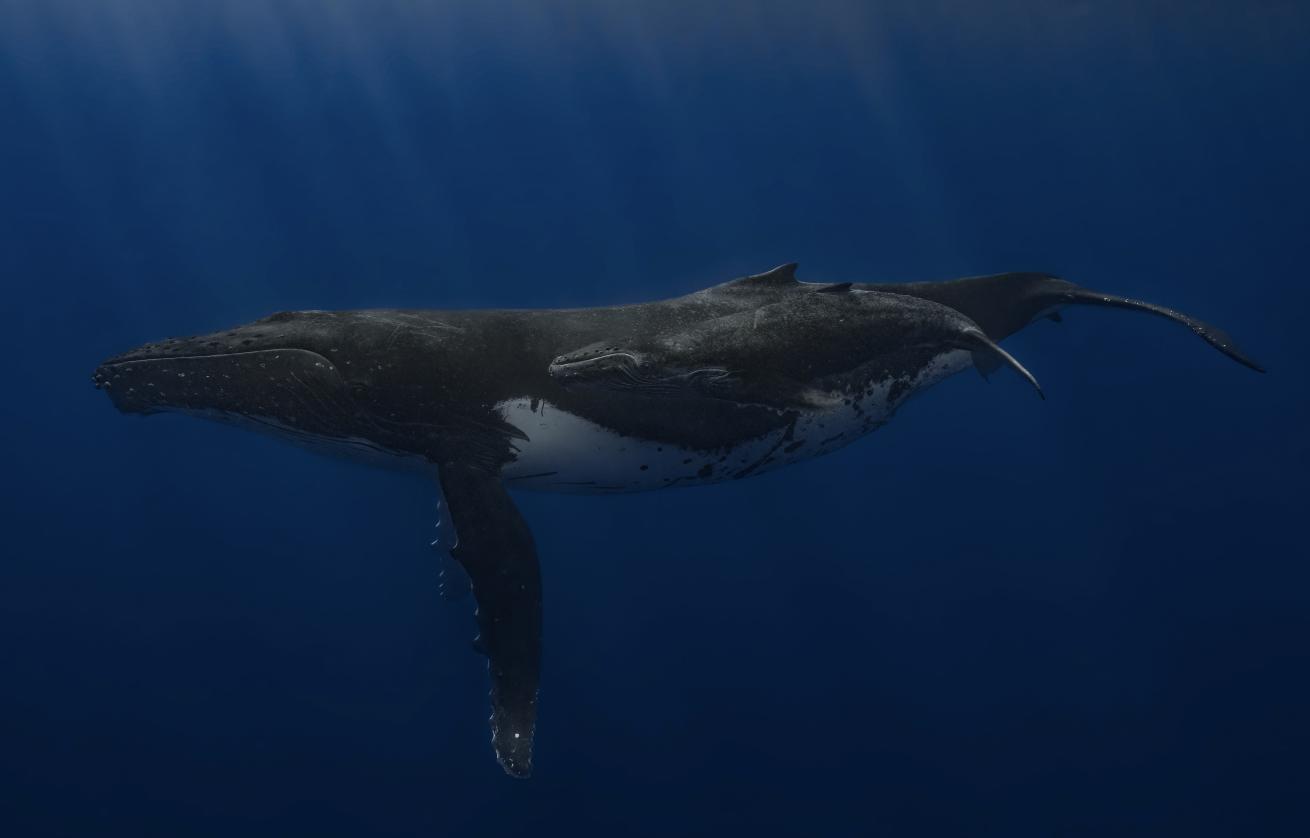
Courtesy EYOS ExpeditionsA mother humpback whale and her calf sail through the nearshore waters of Makatea.
Slipping into the water, the ocean’s warmth wraps around me. The humpbacks emerge like phantoms from the blue, immense and ethereal just feet from the surface. The calf takes a breath as the mother, in a ballet-like pivot, faces us directly. Together, they sail by—regal, calm, in a synchronized dance of colossal grace. Time seems to stop, the vast ocean silencing all else.
Back in the Zodiac, we race to catch another view. Turning around in the spray, I am awe-struck—the Hanse Explorer is tailing us. Not only has the crew spotted the whales and changed the day’s itinerary for us as a result, the captain is now following to shorten our return to base camp. This is a level of attentiveness beyond my wildest expectations.
Unable to spot the humpbacks again, we redirect to the vibrant shore reefs. Below, the coral is alive, awash in sunlight, with colorful fish weaving through a bustling aquatic maze. Above, Makatea stands majestic—its lush hills and palm-fringed edges rising sharply against the sky, a veritable fortress of the natural world. The sea’s clarity is mesmerizing, its depths a mystery just beyond reach, with the humpbacks somewhere in the blue yonder.
“The goal of expedition yachting,” Soper tells me, “is to open people’s eyes to these incredible experiences in hard-to-reach places. And once they see it, they want to help protect it.”
Floating in the middle of the South Pacific, I couldn’t agree more.
Where to Dive in French Polynesia’s Tuamotu Islands
1. Fakarava’s South Pass
Fakarava’s South Pass is a world-class drift dive.Depths range from 30 to 90 feet, with a steady current that brings pelagic life into view. Known for its dense shark population, the site is home to hundreds of gray reef, blacktip, and whitetip sharks, often seen in motion against a vibrant backdrop of coral gardens. Schools of jackfish, snapper, and surgeonfish add to the spectacle.
The strong incoming tide makes this an intermediate-to-advanced dive. Divers should also be comfortable with currents and confident in their buoyancy.
2. Fakarava’s North Pass
Fakarava’s North Pass offers a challenging dive experience, with depths ranging from 60 to 100 feet. The currents are stronger and less predictable here than in the South Pass, making it better suited for advanced divers. It is only safe to dive on an incoming current; do not dive when the current is going out of the atoll and into the blue.
The site features dramatic coral walls and deep canyons populated by gray reef sharks, barracudas, and schools of jackfish. Visibility is excellent, and the constant flow of water between the ocean and lagoon ensures there’s always action. Diving the incoming tide, a requirement for safety, is also fortunately the best for clear conditions and the highest chances of pelagic encounters.
3. Toau Atoll’s Otugi Pass
Otugi Pass provides a gentler alternative to Fakarava’s high-energy dives, with calm currents and depths ranging from 30 to 70 feet. The site is famous for its manta rays, which often gather at cleaning stations along the reef slopes. Divers can hover nearby to watch the mantas’ graceful movements as small fish tend to their skin.
This is an ideal site for intermediate divers and those interested in underwater photography, thanks to its relaxed conditions and excellent visibility. Surrounding coral gardens host an array of smaller reef fish, adding color and diversity to the experience.
4. Rangiroa’s Tiputa Pass
Tiputa Pass in Rangiroa is a thrilling dive site for experienced divers. Depths start at 60 feet and drop to over 100 feet, with powerful currents that demand careful navigation. The pass is a magnet for pelagic species, with sharks, barracudas, and jackfish dominating the scene. Hammerheads are occasionally spotted in the deeper sections.
Entering on an incoming tide provides optimal visibility and the best chance of encounters. Post-dive, dolphins are frequently seen in the area and may even approach snorkelers near the surface. The combination of challenging conditions and incredible marine life makes this one of the most exciting dives in the Tuamotus.




